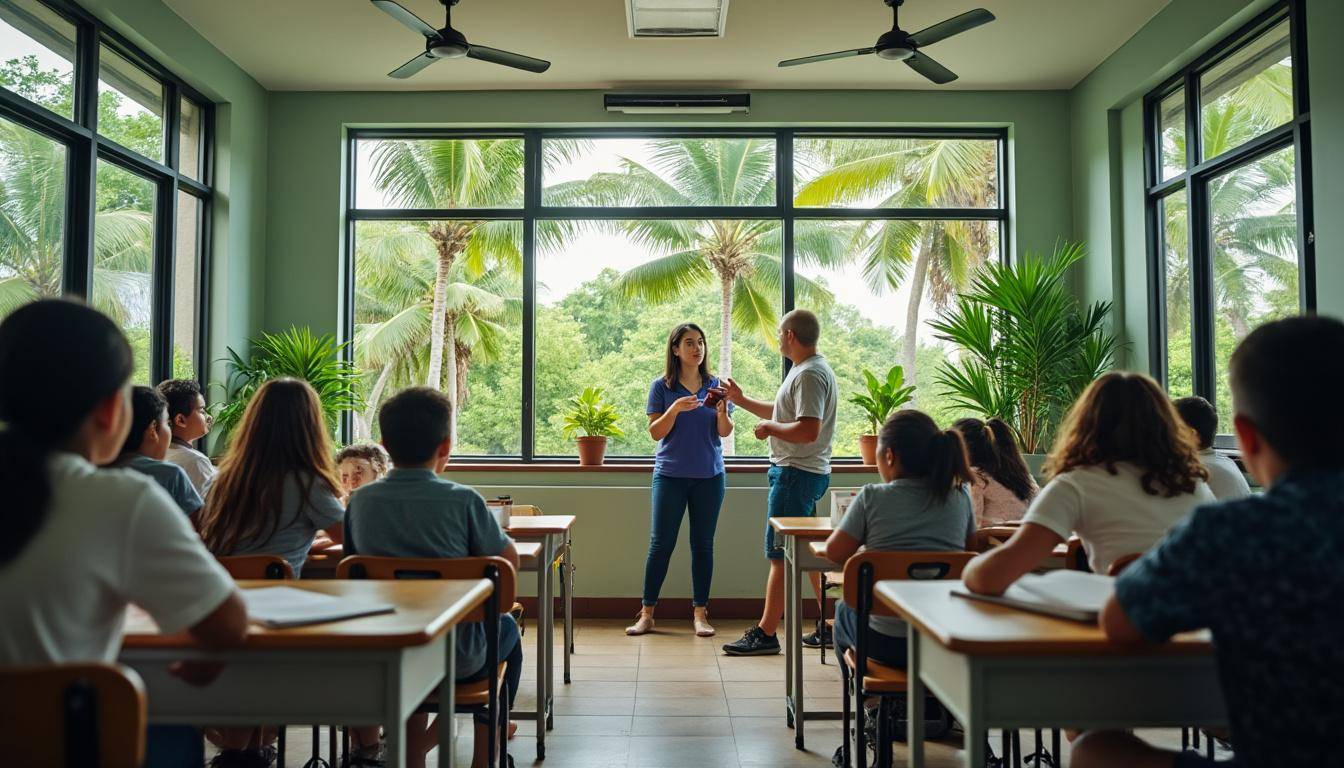As Puerto Rico endures increasingly intense heat waves, its public schools face mounting challenges in safeguarding students and staff from soaring temperatures. The island’s struggle to manage rising heat impacts education profoundly, exposing infrastructural deficits and prompting urgent calls for sustainable solutions. With aging facilities damaged by prior natural disasters and an ongoing energy crisis, schools find themselves ill-prepared to maintain comfortable learning environments in a warming climate.
Impact of Rising Temperatures on Puerto Rico’s School Environments
The frequency of extreme heat events in Puerto Rico has escalated, with record-breaking temperatures becoming the new norm. Students, such as Zedrik in Culebra, often find themselves seeking shade or retreating to inadequately cooled spaces—like libraries or directors’ offices—to escape oppressive heat during school hours.
- Many schools have ceiling fans that operate below capacity due to electrical issues stemming from voltage fluctuations.
- Essential cooling equipment is often damaged or nonfunctional, hampering heat relief efforts.
- Health concerns arise as teachers and students experience heat-related illnesses, notably among younger children who are physiologically more vulnerable.
Guidelines exist for relocating students to ventilated or air-conditioned areas during heat waves, yet practical application remains limited due to infrastructure constraints. The continued energy crisis and slow rehabilitation after Hurricane Maria and 2020 earthquakes exacerbate these challenges.
Consequences of Heat Exposure on Cognitive and Psychological Well-being
Extreme heat not only disrupts physical comfort but also hampers cognitive functions crucial to learning. According to education professionals and UNICEF analyses, children’s attention spans and memory capacities decline under thermal stress, especially affecting socioeconomically challenged students.
- Heat acts as a psychological stressor, aggravating anxiety and concentration difficulties.
- Afternoon classes face significant challenges maintaining student engagement, with teachers reporting frequent disruptions due to discomfort.
- Reported cases of heat-related illnesses in the eastern school region reached over 124 in 2024 alone.
This evolving climatic pattern signals the urgency for creating resilient learning environments that prioritize students’ well-being and educational success.
Infrastructural Barriers and Energy Challenges in School Cooling
Puerto Rican schools grapple with outdated or inadequate ventilation and cooling systems amid chronic energy supply deficiencies. The electrical grid’s fragility, compounded by privatization and recurrent outages averaging four per year, limits consistent power availability for air conditioning units.
- Schools like Escuela Luis Muñoz Marín in Yabucoa resort to community fundraising to acquire basic fans due to insufficient government funding.
- Installed air conditioning units often remain partially operational due to power substation limitations awaiting government upgrades.
- Food services also suffer, with broken refrigeration and lack of proper ventilation impacting meal safety and preparation.
Major manufacturers such as Honeywell, Carrier, Trane, Dyson, LG, GE Appliances, Frigidaire, Panasonic, Mitsubishi Electric, and Daikin represent potential partners in deploying efficient cooling technologies tailored for such challenging settings.
Community and Educator-Led Adaptations to Heat Stress
Faced with limited structural improvements, educators and families adapt creatively to mitigate heat effects. Some strategies include:
- Relocating classes to air-conditioned spaces such as libraries.
- Parents providing battery-operated fans for individual students.
- Organizing school fundraisers and casual dress fees to finance cooling equipment acquisition.
- Seeking advocacy and policy discussions through community forums to demand infrastructural investments.
Such grassroots actions underscore an urgent need for systemic support and investment aligning with education policies, like those discussed in Illinois Education Legislation and Texas educators’ initiatives.
Strategies for Building Resilient Schools Amid Climate Challenges
Addressing extreme heat in schools requires comprehensive strategies encompassing infrastructure modernization, policy reform, and community involvement.
- Upgrade electrical grids and substations to support reliable, high-capacity air conditioning systems.
- Leverage cutting-edge technologies from trusted brands such as Daikin and Mitsubishi Electric for energy-efficient cooling solutions suited to tropical climates.
- Implement architectural designs promoting natural ventilation and shading.
- Integrate heat preparedness plans into educational policies, focusing on safeguarding student health and sustaining academic engagement.
- Enhance resources for educator training and student support to adapt curriculum and foster resilience as highlighted by initiatives like artistic educator support.
Such efforts echo broader movements for nurturing adaptive educational ecosystems worldwide.
Linking Climate Resilience with Equity in Education
Efforts to cool schools also intersect with pressing social issues, including addressing disparities experienced by vulnerable populations. Campaigns like empowering homeless children advocate for equitable access to safe, comfortable learning spaces, reinforcing that climate adaptation must be inclusive.
- Heat disproportionately affects lower-income students lacking adequate home cooling.
- Investment in school cooling infrastructure can reduce dropout rates and improve academic outcomes.
- Community engagement fosters shared responsibility toward sustainable education environments.
Enabling students to thrive academically despite climatic challenges aligns with our shared mission to unlock every learner’s potential, an effort mirrored in educational quality insights from experts such as Rekha.


